Once one of New York City’s only two commercial airports (along with North Beach/LaGuardia Airport) Floyd Bennett Field now borders the southern stretch of Flatbush Avenue between Marine Park Golf Course and Jamaica Bay. Though it’s a National Historic Site, it’s little visited these days, except when flea markets are held there, and much of it lies in ruins.
The old seaplane base on West 31st Street is now a heliport; North Beach is now called LaGuardia Airport.
Floyd Bennett Field’s Administration Building is now called the Ryan Vistor Center.
Constructed on the site of Barren Island and additional landfill, Floyd Bennett Field was New York City’s first municipal airport. The airport is located in the southern part of Brooklyn between Flatbush Avenue and Jamaica Bay, and was completed in 1930 ( a smaller airfield, Barren Island Airport, had been there since the mid-1920s) and dedicated by Mayor Jimmy Walker. The airport initially had only two perpendicular runways. The terminal building was topped by an air traffic control tower and featured modern innovations such as underground tunnels extending from the basement to the ramp area. This allowed passengers to comfortably walk from the terminal to their aircraft in any weather. A barber shop, weather room, pilot’s lounge, passenger lounge, and restaurant were also part of the modern terminal (by the nascent airline industry standards).
Who’s Floyd? From the deepcreekyachtclub website…
Floyd Bennett, born in Warrensburg, N.Y., had lived in Brooklyn and had been New York’s favorite aviator. He enlisted into the Navy for flight training in 1917. Winning his wings, Bennett first served as a test pilot and later as a Chief Machinists’ Mate aboard the U.S.S. Richmond, in charge of aircraft. It was while aboard the U. S. S. Richmond that Bennett met Admiral Richard E. Byrd. In 1925, he accompanied Byrd on the MacMillan Expedition to the Arctic. On May 9, 1926, Byrd and Bennett took off and made history by being the first men to fly over the North Pole. For this feat, both men were awarded the Congressional Medal of Honor. Plans were being made for a second trip, this time to the South Pole. Bennett did not live to realize the triumph of the South Pole Expedition. In April 1928, while suffering a high fever, he heard of the flight of Irish-German crew of the ‘Bremen’, which was forced down at Greenley Island, Quebec, on an attempted non-stop flight from Europe. Bennett was not acquainted with any of the pilots on board the ‘Bremen’, but they were fellow fliers and explorers in trouble, and despite his fever, he took off immediately from Detroit to try a rescue.
At Murray Bay, he was stricken with influenza, but refused to turn back. Halfway on his journey across Canada, Bennett died of pneumonia. Floyd Bennett was buried at Arlington National Cemetery, Virginia. Out of respect for Bennett, Admiral Byrd took a stone from Bennett’s grave and dropped it over the South Pole on the flight that he and Bennett had planned together.
When first built, Floyd Bennett Field’s Administration Building was flanked by eight fireproof hangars, each measuring 120 by 140 feet. Four concrete runways, from 3,200 to 4,200 feet long and from 100 to 150 feet wide, crisscrossed the field. The two towers at the landing zone were equipped with 5,000,000-candle-power floodlights, which supplement the regular beacon boundary, and obstruction lights. Blind landings at the field were facilitated by directional radio beam and a special runway bordered by contact lights.
On this spot, in the rear of the Ryan Center, Howard Hughes took off and landed after completing a round-the-world record flight of 3 days, 19 hours, 17 minutes on July 14, 1938, beating Wiley Post’s old record by more than 4 days. He was met by a crowd of 25,000.
On July 17, 1938, the same month Hughes made his record flight, Douglas Corrigan sought to take off from Floyd Bennett to fly to Ireland, but was denied permission by the Civil Aviation Authority (the governing body at the time) becuase his $299 Curtiss-Robin single engine aircraft was not deemed airworthy. Corrigan then took off for his home in California instead. 28 hours later, Corrigan landed in Dublin, claiming that a faulty compass caused him to fly in the wrong direction. His, er, error caught the public fancy and “Wrong Way” Corrigan received public acclaim upon his return to the USA and a ticker tape parade up Broadway.
A view of the tower from the runway.
Floyd Bennett is not a “dead” airfield. The tower was manned and busy while we were there; and while we were exploring the nearby swamplands, we heard a low roar and sure enough, saw a chunky cargo aircraft rising into the sky through the weeds. Such flights, we’re told, take place about once a week.
This commemorative plaque is hidden at the rear of the tower, evading all but the most persistent seekers.
The plaque dates to the late 1930s when Floyd Bennett was much busier than it is now.
In the above pic you can also see the newly expanded bike path, part of the Gateway National Recreation Area’s emphasis on cleaning up and rehabilitating parkland areas. In Brooklyn alone, plenty of bike paths I remember from my 35 years there as being weedy and full of trash and broken glass have been repaved and maintained. Why’d I ever leave?
Floyd Bennett is now used as home base for the NYPD air squad, the Emergency Services Unit Brooklyn squad, and the field is used to train MTA bus drivers and is also a Department of Sanitation training area. Its once busy runways are mostly desolate.
A November 2004 visit with explorer Andrew N. saw us visit some abandoned warehouses and hangars at the east end of Floyd Bennett Field…
The ruins in the interior of this Public Works building show that Floyd Bennett Field may at one time have had both a church, from which the old pews may have come, and a theatre or auditorium, explaining the very old attached seats.
Andrew felt like a stroll, so he went on the second-floor girders beneath the roof. There was no floor in spots here.
On to abandoned Public Works building #2…
A Sanitation Department training area, empty runways, and a surprisingly good view of distant Manhattan can be seen from the hundreds of Public Works building windows.
We visited another abandoned Public Works building. Probably, little activity in these buildings for the past ten years at least.
Time to visit one of the former hangars. We saw no airplanes, new or old, during this visit, though an adjacent field contains a helicopter port and the occasional cargo plane takes off from here, as explained above.
Forgotten Fan Chris Ciesla of Bagley, Iowa identifies the tool above as a hay rake. [This] particular one looks like a current production item and not just some cast-off junk. The way it works it that when you mow hay, the mower drops the hay on the ground. You let it cure a few days and the you run the hay rake over it to pile it up in neat rows for the baler to pick-up and put in bales.
“I suspect that the city cuts its own hay off of grassy fields to feed to the NYPD Mounted Police horses.”
Our last stop was what appeared to be a former Marine recruitment office.
ForgottenFan Paul Newman: The building on the website you ID as a Marine Corp recruiting station was actually a Marine Corps Barracks for “Weekend Warriors”. There was a permanent Marine Corps Detachment there. Floyd Bennett Field, from the end of WWII to sometime around 1970 was a US Navy Reserve training center. There were a large amount of “Station Keepers” whose job it was train members of the Navy Reserve and also maintain the aircraft at the station. Floyd Bennett was also used as a terminal by members of the congress and high ranking officers having to visit the NYC area. It was also the site used by John Glenn on July 16, 1957 to set a transcontinental speed record flying from NAS Los Alamitos, CA to Floyd Bennett Field in 3 hours and 23 minutes. The Blue Angels also staged air shows from Floyd Bennett when appearing in New York. There was also a Coast Guard Base at the field with helicopter and seaplanes both used for search and rescue. Where the administration building and the hangars along Flatbush Avenue are, the Air Force also had a reserve program whose mission was much the same as the Navy and the Marines.
Marine Park
To the south and west of Floyd Bennett Field can be found vast (about 1800 acres) Marine Park. Until recently, it was mostly ‘wilderness’, but trails are now maintained and residents of Gerritsen Beach and the surrounding neighborhood, also called Marine Park, can revel on a shoreline natire milieu.
The park surrounds Gerritsen Creek, an arm of Jamaica Bay. Gerritsen Creek was a freshwater stream that once extended about twice as far inland, all the way up to Kings Highway, as it does today.. Around 1920 the creek north of Avenue U was converted into an underground stream directed to it’s current release site by a huge pipe or storm drain. Yet it continues to supply the salt marsh with fresh water, which helps the marsh support a wide range of organisms. Broad expanses of fertile salt marsh, meadows adorned with wildflowers, sandy dunes held in place by beach plants, and jungle-like thickets of shrubs and vines dominate the western lands of Gerritsen Beach’s landscape (Marine Park). Myrtle warblers, grasshopper sparrows, cotton-tailed rabbits, ring-necked pheasants, owls, opossums, cranes, horseshoe crabs, and oyster toad fish are a small sampling of the animals that inhabit these plant communities and live in or around Gerritsen Creek.
The creek was probably a favorite hunting and fishing spot for Indians living in the nearby Keshawchqueren village. Archaeological excavations in Marine Park have revealed food preparation pits dating from 800 to 1400 A.D. and containing deer and turtle bones, oyster shells, and sturgeon scales. The first Europeans to settle here were the Dutch, who found the salt marshes and coastal plain of southern Brooklyn reminiscent of Holland’s landscape. Their diet consisted of farm produce, livestock, game, and harvests of oysters and clams.
At the turn of the century developers began making elaborate plans to turn Jamaica Bay into a port, dredging Rockaway channel to allow large ships to enter the proposed harbor. Speculators anticipated a real estate boom and bought land along the Jamaica Bay waterfront. Fearing that the relatively pristine marshland around Gerritsen Creek would be destroyed, Frederick B. Pratt and Alfred T. White offered the city 150 acres in the area for use as a park in 1917.
After a seven-year delay the City accepted the offer. The prospect of a new park inspired developers to erect new homes in the area, although park improvements were slow to follow. Fill deposited in the marshlands in the 1930s and new land purchases increased the park’s area to 1822 acres by 1937. That year the Board of Aldermen named the site “Brooklyn Marine Park.”
Gerritsen Creek, and nearby Gerritsen Avenue, take their names from the Dutch Gerritsen family, who owned property where Marine Park is now as early as the mid-17th century. The family had a milling operation that ran continuously from two buildings in the Marine Park area until 1934, when the second of the two mill buildings burned down…perhaps by arson.
The mills had wooden machinery, leather beltings and large revolving millstones. It was on the edge of the basin into which poured the sea when the rising tide opened the flood gates of the dam that crossed the narrowest part of the creek (originally Storm Kill, later called Gerritsen’s Creek). When the water reached the top of the dam, the gates closed with a full pond behind them. A gate in the sluiceway in the back of the mill could be raised by hand by means of a ratchet wheel, and thus allow the water to flow over the mill wheel as needed.
The second of the two mill buildings is shown here; it was most likely built around 1755. This mill was in continuous operation by the Gerritsens until the late 1890s; William S. Herriman, the last person to run the mill, sold the property in 1899 to the Whitney family, who used the acreage as a training area for his stable of race horses.
These days the old mill is represented only by a group of wooden pilings in the creek.
Over the past sixty years, portions of Marine Park have been improved with recreational facilities, while other areas have been conserved to protect wildlife and plant life. In 1939 the Pratt-White athletic field, north of Avenue U, was dedicated in tribute to the two fathers of Marine Park. A 210-acre golf course opened in 1963. New ballfields, on the west side of Gerritsen Avenue, were opened in 1979 and named for baseball lover and police officer Rocco Torre in 1997. Nature trails established along Gerritsen Creek, on the west side of Burnett Street, in 1984-85, invite parkgoers to observe a wealth of flora and fauna. Ongoing improvements at the end of the 20th century include the reconstruction of basketball, tennis, and bocce courts; of baseball fields; and of Lenape Playground at Avenue U. A new nature center opened in 2000.
In 1974, the Gateway National Recreation Area, a national park, was established. Over 13,000 acres of city parkland in Brooklyn, Queens and Staten Island were transferred to the National Park Service in this major reassignment of jurisdiction over the city’s parks, beaches, and wetlands. 1,024 acres of the new Gateway National Park came from Marine Park.
Sources:
Old Dutch Houses of Brooklyn, Maud Esther Dilliard, Richard R. Smith 1945; out of print
The Neighborhoods of Brooklyn, Kenneth T. Jackson, ed.; Yale University Press 1998
4/5/03; updated 2004, 2012











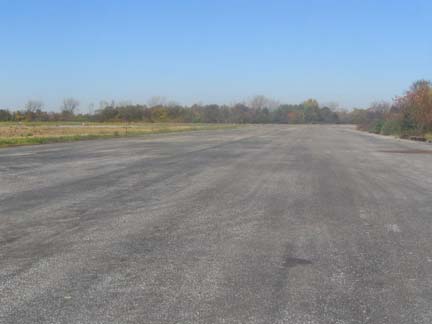






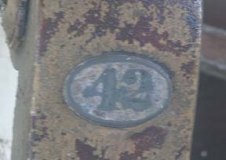










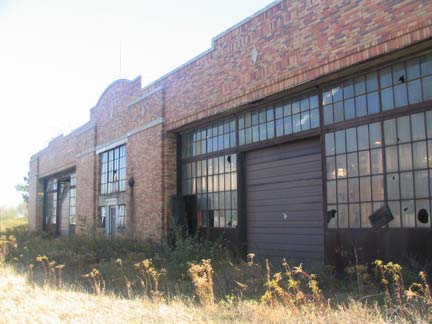

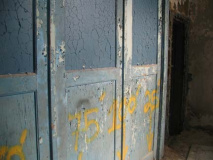

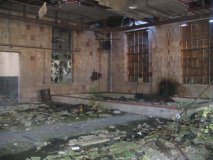



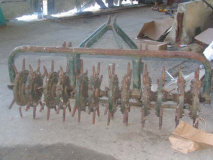









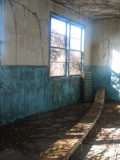


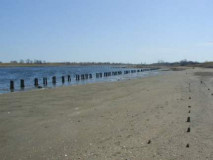


52 comments
Great article Kevin!
This is remarkable. I’m amazed how so many things have been done to this space and tried but no success …
No where to you mention the Men who Volunteer a Hanger B where we restore old military planes for the last 17 years. You show all the old buildings falling apart how about the planes we restore.
HARP is Historic Aircraft Restoration Project. Come by were open Tues-Thurs-Sat-
.
Bob WEiss
I was a young Marine just graduated from the Naval Air Training center, Millington Tennessee. My First duty station was NAS New York, Floyd Bennett Field. from 31 March 1964 to 31October 1965.
I was a member of the Marine Air Reserve Training Detachment. Approximately 35 or 40 Marines were posted there, our assignment was to maintain the Marine Reserve Aircraft of VMA 131 and train Marine Reservists. I wonder if anyone could locate a roster of the Marines in the MARTD. If so I would be eternally Grateful. Cpl William Bobzin USMC
I am looking for a buddy that was stationed during the early 60’s. His name (please excuse the spelling) named Mike Marinazzo. Please have him contact me.
Was it Mike Mannarino?
i was a USMC Reservist in the late 60’s and served in a helicopter squadron HMM768. We moved to Lakehurst NJ in “69 or 70.
i was a Marine Reservist In a helicopter squadron HMM768 in the late 60’s. we eventually moved to lakehurst nj
I was a 3rd class storekeeper in the NAVY at Floyd Bennett Field (1969-1971). I was one of only 3 NAVY persons on the base when we closed it down under President Nixon.
If I’m not mistaken when the NAVY occupied the airbase by the water along with the Coast Guard, the NYC Police Air occupied one hanger along Flatbush Ave. Also along there was the U. S. Air Force & U. S. Army.
My father, Walter S. Ingram, was a station keeper at NAS New York – Floyd Bennett Field – c. 1954-55. I have a photo of me at age 6 standing in front of the converted barracks where my family was housed. My brother was born in St. Albans in Queens while we were living there.
Would love to hear from anyone with memories from that period who was there or may have known my dad.
[…] Ryan Center, which has undergone an extensive renovation, now serves as the Administration […]
I grew up in mill basin,
we used to play street hockey in those old hangers. The floor was really smooth and no cars to interrupt us !
What a memory
My first foray into the Forgotten world here. I also enjoy Bernard Ente’s oldNYC dot com.
I have an old boat at Gateway Marina across the street on Flatbush Ave. I have visited the Historic Aircraft Restoration Project after speaking with a gentleman in an (’61?) red Austin Healy – gorgeous.
I met him by the bike path at Plum Beach. Anyways, I ride the bike over to the east side of the field. Amazing! Gorgeous old “aeroplanes” (as my old instructor used to say) in the hangar. Worth a trip!!
My flight instructor, Tom Murphy, used to fly a biplane out of Barren Island Airport in the ’30s. “Drink Pepsi Cola 5 c ,” over Times Square. He said they stopped that during the war. He last flew out of Coram Airfield and Bayport Aerodrome and sadly passed in 1996.
I have a picture of myself at the field next to a Lockheed Neptune there in 1976(?).
I was there for the fly in to mark the 75th Anniversary of the field. Lots of antiques and warbirds flew in for the occasion.
Now my friends camp at the campgrounds there. There are garden clubs that maintain plots there as well. The place is as rich in aviation history as they come.
Stories of other fields can be found at: airfields-freeman dot com.
Aviator Sports dominates the place at Flatbush Ave. New natural gas pipeline runs up Flatbush Ave.
The marina site – Gateway Marina / Barren Island Marina has been a marina there for a long time as I see boats moored / docked there in aerial photos from long ago.
Best of luck,
Victor K.
vsk
Having been stationed at NAS New York (Floyd Bennet Field in 1965-1966, I thoroughly enjoyed the pictures. Brought back some memories. I live in the Hartford, Ct area and definitely plan on taking a special trip for a visit.
[…] Floyd bennett field | | forgotten new yorkforgotten new york Once one of new york city’s only two commercial airports (along with north beach/laguardia airport) floyd bennett field now borders the southern stretch of flatbush. […]
I was a station keeper 1959 to 1964. I worked in the Supply Building (A very large 3 store bldg. near the Public Works area). I also tended bar at the EM Club (Now burned down). I lived in the barracks, near the chow hall. I met a lot of wonderful people from Brooklyn , I ended up being married to a Brooklyn girl. I used to serve as a duty driver and picked up VIPS when they flew into the base. I am now retired and live in Saint Petersburg, Florida. I served 22 yrs. in the Air Reserve & Regular Navy.
James,My father,Sydney Perks was stationed there from 1961-1965 and was administrator of the CPO club. His rate was ams master chief. Did you know him.? Wayne Perks
I was stationed at Floyd Bennett from 1959 to Feb 1963 MOS was 6441: Aviation Structural Mech.USMC!!!! Because of my training I got a job with Grumman Aerospace!!!!
Hi!
This is an excellent article – true for virtually all on Forgotten – NY.
You mentioned that Adm. Byrd and Mr. Bennett received the “Congressional Medal of Honor.”
The correct name for this award is the Medal of Honor (see the MOH website). Congress has nothing to do with it. This is proven in that, if Congress was involved in the award, every Congressman and every member of his family, including his dog, would have one.
Well done!
Cheers,
James
I served in the Naval Reserves at this station in the 1960’s before being shipped to the west coast and serving in Viet Nam. I have wonderful memories of this base, as it was my first taste of Naval service.
Bob Jackson, AO2
USN Retired
you omit the fact that the field was used for the first transatlantic flight in 1938 when LUfthansa landed a plane there.
I remember we used to hang out in Riis Park and listen to the World Series and watch the F-4 Phantoms take off and land there in the late 60s. And they had an F-80 or 86 positioned at the entrance of the field.
Someone mentioned to me that right after 911, they had a considerable build-up of troops and equipment there. Anybody have pics or memories of this??
I remember seeing a formation of at least 5-6 formidable looking helicopters heading that direction at the time
I was stationed at Floyd Bennett field from 1956 to1959. I was on the S2F line. I live in pa. I was called Moon Mullins. Like to hear from someone.
I was stationed there at Floyd Bennett as a regular Air Force airman , training Reserve
Air Force personal from 1955 to 1957 , Our Barrack and Hangers were along Flatbush Ave.
there were about 60 stationed there ,
I took my training at the 2230 arfc .then I enlisted in reg usaf looking to find any thing I can about the reserve unit can youy tell me anything you know will be most thanlful the year was 1953-1954 thank you
Was wondering why there was no mention of the fact that Floyd Bennett Field served as an active US Navy air field during WWII. I lived about a mile from the field. Planes (Avenger torpedo bombers, Hellcat and Corsair fighters, etc) constantly flew over my house at low altitudes during take off and landing. I believe they were mostly on submarine patrol.
Also, I remember as a child, I would ride my bike to the field to look at the planes before the War and during the War.
It’s a shame that this part of the field’s history was neglected.
I was assigned to vp837 p2v squadron. have many fond memories of the men that I served with from 1960 to 1966 at Floyd Bennett field.
I was a sea cadet training there from 69 to 71 fueled p2 neptunes and A4s worked in hanger A.
A few months ago I happened to be near there and took a ride to see what was left to my surprise my barracks on enterprise st were still there.
served with usmcr in 1957 / weekend each month / think a gunny Carpenter was there – – -what became of the guy ? we went to school together in Astoria – – now i am living near Cherry Point USMC AIR BASE Thanks for the nice coverage on Floyd Bennett.
Was stationed at Floyd Bennett between Dec 52 and Sep 54 with a reserve unit, the 8709th Pilot Training Wing. We were trained by the 2230th Air Force Reserve Flying Training Center and had T6, T28, T33 and C45 aircraft. The side of the base along Flatbush Ave was called the Air Force side, while the Navy Side. The Air Force side consisted of our unit, a NYANG bomb wing flying the B26, and the NYC police air unit. The other side (Navy) was mostly naval units. My first flight was an orientation flight around NYC at night in a Navy R4D (AF C47) and the briefer was Lt Comdr Aurther Godfrey (radio and TV personality). Did basic training at Floyd Bennett and Mitchell AFB. Did weapons training at either Ft Tildon or Ft Totten.Left there to join regular AF in Sep 54 and retired in Mar 80. Great memories Guy from Brooklyn. First duty assignment with Regular AF was at Minneapolis/St Paul Intl Airport, MN training AF reserves.
I was in the navy reserve band around 1955,went away to college, came back, no band, finished my service doing clerical stuff with the waves. I was the best gofer the station ever had. I was also quite extraordinary at cleaning tables in the mess hall.
I was a plane Captain in the Naval Reserve there from Feb. 1951 to Jan. 1953. I cannot remember the fighter squadron I was attached to at that time, but I do remember pre-flighting Grumman Helcats and torpedo fighter planes during my training before the young pilots went out on practice runs. I would appreciate anyone with knowledge of those VF squadrons (numbers?) operating out of Floyd Bennett Field at that time. Thanks. You can email me if preferred since I may never find this exact website next time fr that info.
thewizardoftoz@yahoo.com
My Father was an Airplain mechanic at Floyd Bennit field prior to WWII . After The Pearl Harbor invasion my Dad and a bunch of his co workers I listed in the US Navy and of course they were assigned to Aircraft Carriers for their skills . Floyd Bennit Field and all these men were extremely instrumental in winning WWII . Truely the Greatest Generation .
My father my brother and I reserved at Floyd Bennett vp832 joe krudis
I was in the Navy Reserves from January 56 to January 60 and packed parachutes. Waves were then not allowed to continue in rank and did clerical work. Flew in S2F when rigger.
I was also station there from 1958 to 1960 navy reserves vs 832 on the s2f I was amh2
My name is also Roy i serve in1957 went on active duty in 1958 and return in1960 what happen to vs 832 can’t find any info work the line also amh3
I AM RESTORING AN S2 E AIRCRAFT AT HANGER B -F B F. DO U HAVE PHOTOS OF THE S2F DURING YOUR STAY AT F B F ? EASTRIVERHOBBYS@YAHOO.COM /MARIO
Fun memories of a great aviation icon. I was assigned to the 2230th Air Force Reserve Flying Training Center in Sept 1954 as Headquarters Squadron Section Commander. All services were represented and had vigorous flying training programs. NY Police were an important presence along with US Coast Guard flying both rotary and fixed wing rescue craft. We all felt we were participating in important missions. In USAF archives somewhere there is a formal history of the 2230th AFRFTC (later 2230th Air Reserve Flying Center0 documenting their record. I know: I wrote it.
I was stationed at Floyd Bennet from November 1962 till November 1965. I was a YN3 in the Recruiting Department. My uncle was Charlie Kain a PN1 in the same department. Was active in sports and once beat Captain Shaw on the handball court and got a free dinner for my wife and myself in New York City by the captain and his wife.
Robert,My father,Sydney Perks was stationed there from 1961-1965 and was administrator of the CPO club. His rate was ams master chief. Did you know him.? Wayne Perks
I was stationed at Floyd Bennett from Nov 1962 to Nov 1965. I was a journalist 3. I worked on the Skyscraper news at information and recruiting
I was looking for photos of the Army section, I was stationed there in 1964 for a short while
my husband was stationed at Floyd Bennet circa 1957. Does anyone recall when the navy and marines went to the premiere showing of south pacific? Marines were all in their dress blues and the sailors in their best garb. I was 17 and it was a fairytale for me. Any literature of that day? What theater was it at? I remember seeing Sal Mineo the actor in the lobby of the theater. Marines were seated on the balcony and I looked down at the lower level I saw a sea of white, all the navy men. I’ll never forget it.
I came out of USN Serving 4 yrs active .Joined USNR Was attached to HS832 for a few yrs . Flying the HSS-1 (H34J) .Then to the SH3As , HS70R2 ,(H3s) Was assigned to the Line as a LPO (AD2 ) Was a Plane Capt in USN in HS-4,& HS-8 on Both the USS Boxer CVS21 & USS Princeton CVS 37, 6 months cruises ,then transfeered to HTG Ellyson Fld (P) Cola Fl Went from E 1 to E5 in 2 yrs ,both R&J schools . Enjoyed Working at Floyde Bennett I worked fo New York Airways Helicopter Service At LGA Was at Floyde until it closed ,then there in NAR Divs Then from there to USS Intrepid CVS11 ,in NY harbor ,Then to Fort Wadsworth, Back to Tyunishall as a instructor . Sent to IAMD Norfolk for weekend duty to help USNs high tempo. Floyde Bennett ,was asked to come up with enough Sailors to fill the First Augmentation Group to fill the Reserve Billets on the USS Nimitz CVN 68 , I was a AD1 & picked to serve on her Made Chief on her in 1986 Transferred to the USS JFK CV67 . When Nimitz went West Pac , Ended up in a Pay billet In HM 18 as a line Chief for 3 yrs , HYTed out , I yr in the IRR doing Courses Back into a New VTU 8686 Norfolk ,Back to HM18 ,then HM14 integrated USN/USNR Retired with 41 yrs 1 month 1day 10 Gold Stripes ( Never got Caught) Activated for the NYC Mail Strike in 1970 ,3 days US Army Post Office Brooklyn NY
I am trying to trace the history of my Curtiss-Wright Travel Air 16-E, NC12352 which was an “instrument trainer” own &
operated by Erickson & Remmert of Floyd Bennett Field & Lambert Field St.Louis. Any direction, photos, connections etc. are greatly appreciated. Thank You, Steven L. Dawson, 262-203-3407
Robert E Jackson. I enlisted in the Naval Reserves in 1964 and went on to serve in the South China Sea during the Viet Nam war. I have many good memories from this base HOooooRAaaaa.
I was an enlisted naval air atr4 when i was discharged dec 14 1968. I had a band caled the vibros that played at the em club and a few gigs at the marines club as well neighborhood bars. Many good memories working on as an airman doing the kp stuff with a good friends was not so bad. We even had a bowing alley installed and we took first place the short time it was built. I even dated the sec that worked for the captain on the base.
Did three years active duty at this base kept my brand new 1965 gto and gas at coast guard station was only 25 cents ha. As an atr was good times working in the hanger many days and nights…
I served in the USMC Reserves in the late 60s at floyd bennett field, HMM 768 helicopter squadron which eventually move to Lakehurst NJ
Enlisted in the reserves in 66-67 there. Went to boot camp in summer 67. The TAR 85 day boot camp. Did my one weekend a month there till 69 then went to NATTC Memphis for A school. Ended up in Willow Grove for the rest of my time. Many memories.